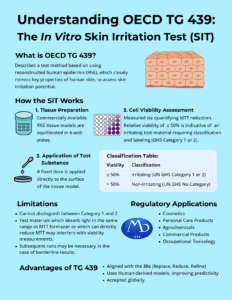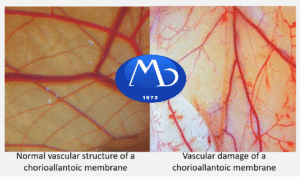The Buehler Test
(OECD TG 406, OSCPP 870.2600)
A Classic In Vivo Approach to
Skin Sensitization
Introduction
MB Research Labs has extensive expertise in evaluating materials for their potential to induce delayed contact (Type IV) hypersensitivity using the Buehler closed-patch technique. Our team possesses unparalleled knowledge and proficiency in conducting GLP-compliant Buehler Tests according to OECD 406 and the U.S. Environmental Protection Agency (USEPA) OSCPP 870.2600.
The Buehler Test is an established in vivo method for assessing the skin sensitization potential of chemical substances. Developed by Edwin Buehler in the 1960s and standardized for regulatory use, this test remains one of the two traditional guinea pig assays historically used prior to the advent of alternative non-animal methods. Although now largely supplanted by modern in vitro non-animal assays and defined approaches, the Buehler Test continues to provide a reliable benchmark for evaluating contact sensitization.
Experimental Design of the Buehler Test
Reliability Check
The sensitivity and reliability of the techniques are confirmed with a known mild-to-moderate skin sensitizer tested within six months prior to evaluating a new substance. Preferred positive control include hexyl cinnamic aldehyde (CAS No. 101-86-0), mercaptobenzothiazole (CAS No. 149-30-4) and benzocaine (CAS No. 94-09-7). Positive control concentrations should yield incidence rates near the sensitization threshold.
Vehicle Selection
For materials soluble in aqueous systems, distilled water is used during induction and challenge phases. For materials insoluble in water, ethanol is used for induction and acetone is used for the challenge phase.
Screening Phase
A preliminary irritation screen (pilot study) is performed to determine the concentration of the test material to be used for the induction and challenge phases of the main test. The highest concentration that does not produce more than a slightly irritating response (erythema responses not exceeding grade 1) is used for the induction phase. The highest non-irritating concentration that does not produce more than a very slight erythemic reaction (erythema responses not exceeding grade 0.5) is used for the challenge phase.
Main Test
- Induction Phase: Test group animals (20 guinea pigs) are dosed topically with 0.4 ml or 0.4 g of the test substance under occlusion for six hours, once per week over three weeks (total of three exposures) on the same site. Skin reactions of the animals in the Test Group are observed 24 and 48 hours post-exposure. Control Group animals (10 guinea pigs) remain untreated for the three-week induction period, serving as a naïve control.
- Rest Period: Following induction, a non-treatment period of approximately 10 to 14 days allows for the development of a potential immune response.
- Challenge Phase: All animals are challenged topically on a naïve (untreated) site with 0.4 mL or 0.4 g of the test substance under occlusion for six hours. Reactions are evaluated 24 and 48 hours post-challenge exposure.
Interpretation and Scoring
Skin reactions are scored using a standardized dermal response scale.
Score Description
0 None (no reaction)
0.5 Very slight (very faint erythema usually non-confluent)
1 Slight (obvious faint erythema, usually confluent)
2 Moderate (moderate erythema)
3 Severe (strong erythema, with or without edema)
Sensitization of the test system is evaluated following the challenge exposure by comparing the extent and degree of skin reactions in the Test Group to the Control Group. A positive response is defined as a score of at least 1.0 and that exceeds the highest response observed in the Control Group. While the scoring system is relative, the most important criterion of an overall positive response is whether the Test Group animals are more responsive than the Control Group animals following the challenge exposure; this comparison allows discrimination between reactions of hypersensitivity versus skin irritancy.
To evaluate the sensitization potential of a test article, two endpoints are used: incidence and severity.
- Incidence is the percentage of animals that exhibited a positive response at either 24 or 48 hours following the challenge exposure when compared to the total number of animals in the group. For a test article to be considered a sensitizer in the Buehler test, at least 15% of the Test Group must exhibit positive responses.
- The evaluation of response severity (i.e., the sum of erythema scores divided by the total number of animals in a group) is used to compare the Test and Control Group responses. If the severity of the responses of the Test Group is greater than the Control Group (e.g., the Test Group has a large number of 0.5 scores [non-positive response] but no responses are observed in the Control Group), then a rechallenge may be warranted.

Buehler Test – GHS Classification Criteria
Applications and Regulatory Relevance
Compared to the Guinea Pig Maximization Test (GPMT), which uses adjuvants and intradermal injections, the Buehler Test is less invasive and has a milder induction approach, resulting in lower sensitivity but fewer false positives. The Buehler Test has been pivotal in hazard classification and labeling under major regulatory frameworks like REACH (EU), TSCA (USEPA), and UN GHS.
With increasing regulatory emphasis on New Approach Methodologies (NAMs), multiple validated alternatives and non-animal methods are now available such as the Local Lymph Node Assay (LLNA; OECD TG 442), the Direct Peptide Reactivity Assay (DPRA; OECD TG 442C), the Are-Nrf2 Luciferase Test (KeratinoSens™; OECD TG 442D), and the Human Cell Line Activation Test (h-CLAT; OECD TG 442E). However, the Buehler Test remains valuable for skin sensitization evaluation when the test materials are incompatible with the alternative or in vitro test systems or when regulatory requirements necessitate in vivo confirmation.
Conclusion
While the Buehler Test is increasingly viewed as a legacy method, it remains a well-established reference assay, which has contributed significantly to the understanding of skin sensitization mechanisms and continues to be recognized in regulatory guidelines where validated alternative methods are not applicable.
MB Research provides expert GLP-compliant sensitization testing services for regulatory submissions, with decades of experience.
Is your product a potential skin sensitizer? Contact MB Research Labs to explore our full suite of skin sensitization tests.
References
Buehler, E.V. (1965). Delayed contact hypersensitivity in the guinea pig. Arch. Dermatol., 91, 171.
Ritz, H.L. and Buehler, E.V. (1980). Procedure for conducting the guinea pig assay. Current Concepts in Dermatology, Drill V.A. and Lazar P. (eds), Academic Press, New York, N.Y., 25-40.
Buehler, L.V. (1994). Occlusive patch method for skin sensitization in guinea pigs: the Buehler method. Food and Chemical Toxicology, 32, 97-101.




